

The works in this exhibit are all later versions or publications of titles, authors, or documents that are represented in the Rouse Medieval Manuscript collection. The exhibit content was created by students in a History of the Book seminar in Winter 2014 in the Information Studies Department at UCLA.
Exhibit Home
1. An exact collection of all remonstrances,...
3. Divi Avrelii Avgvstini Hippon. Episcopi...
4. Horae in laudem beatiss[ima] Virginis secu[n]dum....
5. Hore in laudem beatissime Virg[inis] Marie...
6. Les memoires, contenans le discours de plusieurs...
7. Modus Bene Viuendi (Modus Bene Vivendi)
8. Psalteriu[m] v[ir]ginis sanctissime [secundum]...
9. Q. Asco. Pediani In Ciceronis orationes...
10. Quaestiones super XII libros Metaphysicae...
11. Stimulus diuini amoris Sancti Bonauenturae
12. Varii sermoni de Santo Agostino...
13. Varii sermoni di Santo Agostino
Title Q. Asco. Pediani In Ciceronis orationes
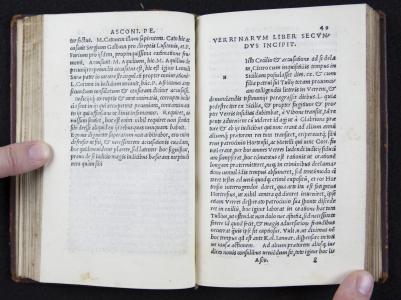
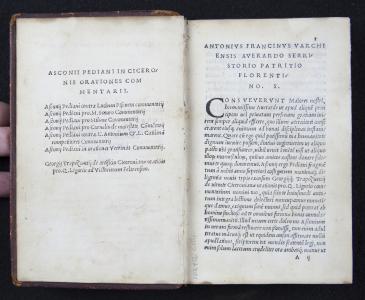
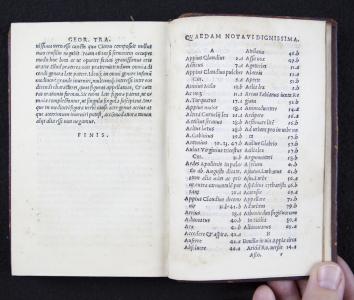
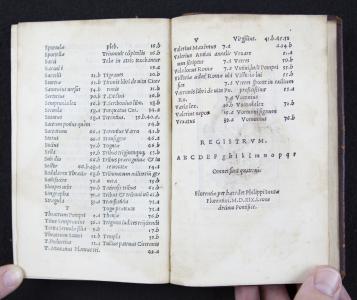
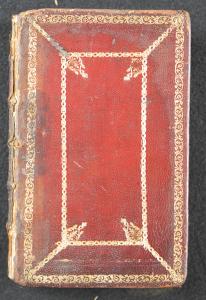
Brief description Everyone’s a Critic: Quintus Asconius Pedianus (c. 9 BC – c. AD 76), a Roman historian, wrote commentaries on various speeches by Cicero for his sons in a vocabulary that they could more easily understand. These personal writings were later discovered and published in what is known as Q. Asco. Pediani In Ciceronis orationes commentarii; atq[ue] Georgius Trapezuntius De artificio Ciceronianae orationis pro Q. Ligario / nuper maxima diligentia excusi. Their content merited publication because they reinterpret Cicero’s speeches into a language that is more accessible, and they give context to the historical period in which they were written. Here we find commentaries on fragments of five speeches that were not completed by Cicero.
Physical description Appears to be bound in leather. Paper/substrate: marbled endpapers; all edges gilt.Printing Method: According to the UCLA catalog record for this book, the copy held by Special Collections was bound by the 18th century bookbinder Roger Payne. Production techniques: Possibly moveable print
Content description Commentary by Asconius Pedianus on speeches by Cicero. Written from anywhere between the 70s B.C. to 43 B.C. in ancient Greece. It reinterprets the complexity of Cicero’s speeches to a vocabulary that Asconius’s sons could understand. When the commentaries by Asconius were re-discovered in the Middle Ages, they were considered valuable for this same reason, which is why his works were published. Also, they provide historical context for the time in which they were written; the references made by Cicero in his speeches, what he was writing about, and how it was written are all contextual clues for the era in which they were written. “It is… very likely that the initial inspiration behind the Commentary was [Asconius’s] desire to prepare his sons for a career in public life at Rome by enabling them to read the speeches of the most distinguished orator of the Late Republic with proper understanding.” (Squires viii). “We can assume that [Asconius] migrated to Rome at some point in his life, and that he writes at least partly for readers who were like himself provincials” (Squires vii). Prior to reproduction, the original works were for his sons. It can be assumed that the publisher’s intentions were to target a larger audience, including people who wanted to understand Cicero’s intellectual rhetoric but could not. It can be inferred that the text was originally written for personal use, since Asconius wrote it for his sons. The authors of the text are Quintus Asconius Pedianus, Antonio Francino, and Marcus Tullius Cicero. “In Senatu Contra L. Pisonem,” “Pro Scauro,” “Pro Milone,” “Pro Cornelio,” and “In Toga Candida” are other significant writings. In “Asconius,” translated by Simon Squires, Asconius Pedianus is referred to as a “distinguished historical writer,” which must have meant he was fairly influential. However, as previously mentioned, his Commentaries were pieces written for his sons, which seems to indicate that the text was not one that was well-read in its time.
Contributor: Javier Garibay
Contribution date: Winter 2014
Full title: Q. Asco. Pediani In Ciceronis orationes commentarii ; atq[ue] Georgius Trapezuntius De artificio Ciceronianae orationis pro Q. Ligario / nuper maxima diligentia excusi.
Date 1519
Location Florentiae (Florence, Italy)
Dimensions 16cm
Technologies of production
Additional information A search of the title on WorldCat shows additional copies at Brigham Young University, University of Notre Dame, University of North Carolina at Chapel Hill, and Columbia University. A version of this book is available through Google Books at https://play.google.com/store/books/details/Quinto_Asconio_Pediano_Q_Asco_ediani_In_Ciceronis?id=hLa-Fmg2u70C A closer search of Quintus Asconius Pedianus on WorldCat shows twelve editions of Commentaries on speeches of Cicero published between 2006 and 2011 alone in English and in Latin.
ConditionSpine damage, severe wear, cover boards falling off of book, heavy water damage (pages are wavy; visual marks indicate contact with water as well). It was heavily used in its time, and not well cared for. The wear could also have resulted from age.